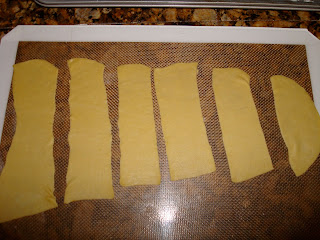A few years ago, I was introduced to the wonder that is a pignoli cookie. Pignoli, or pinoli, being the Italian word for pine nut, these delightful bites are an almond flavored cookie rolled in pine nuts and sprinkled with powdered sugar. But, have you seen the price of pine nuts lately? Good gravy! While I love the taste the pine nuts add, I also love anything that incorporates almond paste, so I started making the cookies sans pignoli coating.
In fact, one of my first experiences making them without pine nuts was for an afternoon tea with a friend. The recipe made a lot and she enjoyed them, so I sent her home with a tupperware full of extras for her and her husband to enjoy. The report back? "My husband loves these cookies - says they remind him of some his mother used to make." That cinched it. These became a staple.
And then I got creative, mostly because nothing is really ever "finished" in my mind; everything can be improved upon. Plus, I had a lemon tree going nutso in my backyard. I played around with a batch of the almond cookie dough and came up with a lemon version. Wanting to send some to a friend on the East Coast and feeling like I should have more than one variation on a theme, I came up with the dark chocolate version, as well (the first, and failed, iteration of which involved rolling in dutch processed cocoa powder - bitter!).
What follows is the ingredient list and directions for all three variations. Try at will.
Ingredients
1 pouch (1 lb 1.5 oz.) Betty Crocker sugar cookie mix
½ C. granulated sugar
½ C. butter or margarine, softened
1 can (7 or 8 oz.) almond paste (not marzipan)
1 egg
3 T. lemon zest
yellow decorator’s sugar
½ C. 60% dark chocolate chips
Directions
Preheat oven to 350 degrees. For plain almond cookies, mix the first 5 ingredients in a stand mixer until well incorporated. I like to check dough to make sure there aren’t huge chunks of almond paste in places (then again, biting into a chunk of almond paste doesn’t seem like a horrible thing to me!). With palms, roll dough into roughly 1” balls, trying to keep the dough balls a consistent size for each batch. Place onto nonstick or greased baking sheet being sure to leave around 2” of space between cookies – they will expand. Bake for 13 – 17 minutes, until cookies begin to become golden around the edges. Remove from oven and let sit a few minutes. Remove cookies to a cooling rack, but eat at least one while they’re still hot – it’s a religious experience.
For lemon almond cookies, add lemon zest to the first five ingredients and mix until well incorporated, again checking for big pieces of almond paste. After shaping your 1” dough balls, roll in yellow decorators sugar and place on cookie sheet, 2” apart. The rest is the same.
For Dark Chocolate Almond Cookies, make the plain almond cookies according to the directions above. When cookies have completely cooled, melt 60% dark chocolate chips in a microwave safe bowl. To do this, set the microwave to 30 seconds at full power. After 30 seconds, stir chips and return another 30 seconds. Repeat until chips are completely melted. Note that getting water in your melted chips can cause the chocolate to seize (become hard and chunky). This should be avoided so that your lovely baking experience is not suddenly interrupted by large amounts of swearing. When chocolate is melted, dip half of each almond cookie in the chocolate and remove to a piece of wax paper. Finished cookies can be set aside to set up or moved to the refrigerator or freezer for faster setting.
Baker’s note: If you are the creative type, you may even decide to add further fanciness before the chocolate sets. I suggest sprinkling the chocolate half of the cookie with some diced fresh almonds, colorful sprinkles or coconut. Making these for a holiday? Add some food coloring to your dough before baking – red or green dough against the dark chocolate looks very festive at Christmas time. Springtime? How about a pastel dough dipped in white chocolate instead of dark? Don't be afraid to experiment.
Yield - at least 4 dozen. Exact count will depend on how big you make them.







